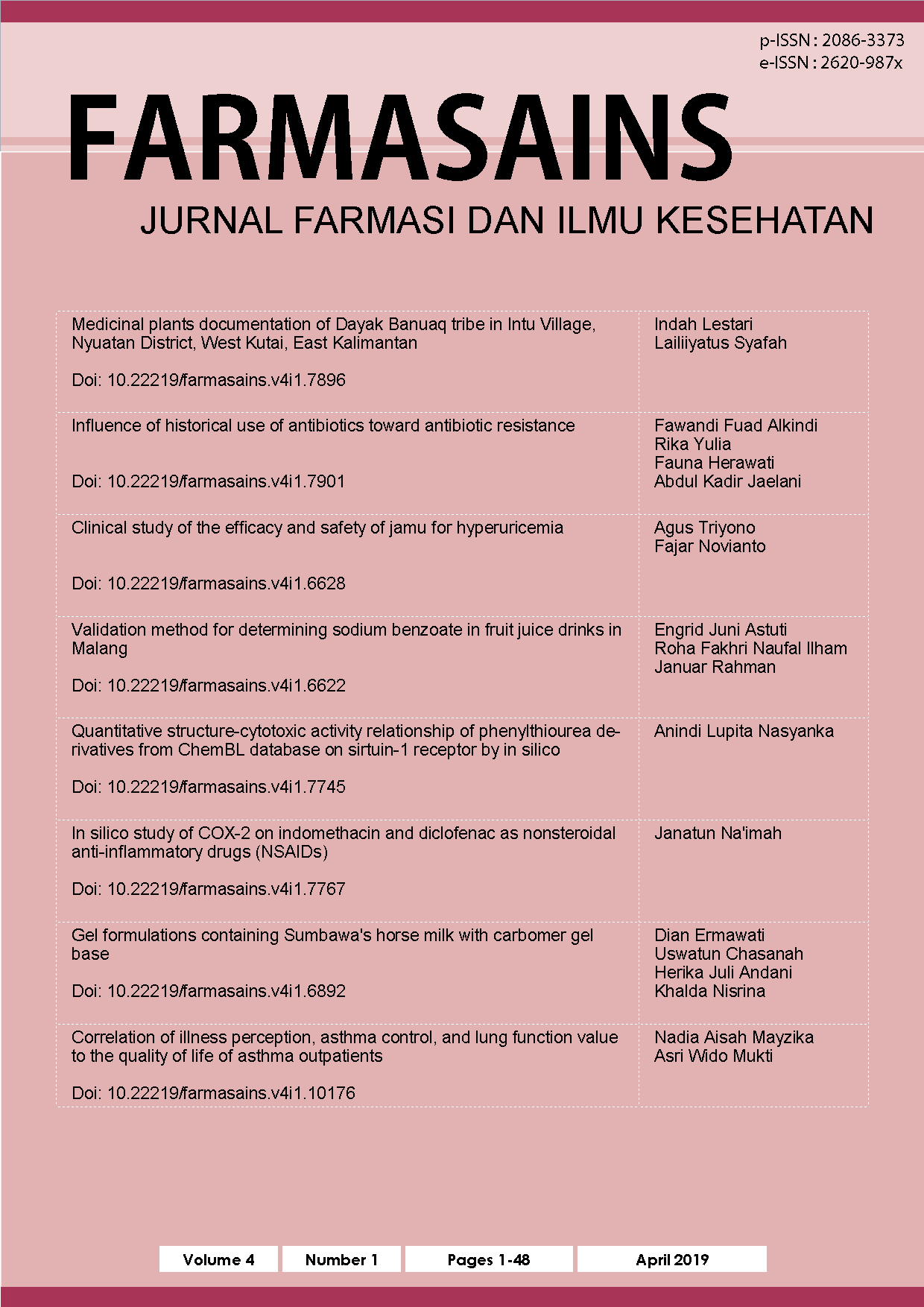Gel formulations containing Sumbawa's horse milk with carbomer gel base
DOI:
https://doi.org/10.22219/farmasains.v4i1.6892Keywords:
Formulation, Gel, Carbomer, Horse milkAbstract
Peptides from Sumbawa horse milk are active as antibacterial and antioxidant. Horse milk has a higher content of vitamin C than cow or goat's milk, and cream products that contain milk can overcome dry skin. The Gel is one of the topical dosage forms suitable for acne medications and oily skin types. This study aimed to determine the effect of variations in horse milk content formulated in gel preparations with carbomer 1% base as gelling agents on physical characteristics (organoleptic, viscosity, pH) and antibacterial activity in Propionibacterium acnes. In this study, gel preparations were made with six different formulas on horse milk content, namely FI (2.5%), FII (5%), and FIII (10%), FIV (15%), FV (20%), and FVI (25%) with 1% carbomer base on each formula and well method were used for the antibacterial test. From the organoleptic test, it was found that in all of the gel formula had soft textured, thick white color, and distinctive aroma like horse milk. The viscosity test showed that was no significant difference, but the pH test showed a significant difference for each formula. In this study showed that all of the gel formulae did not have an inhibitory zone, which means that at each level there was no evidence of antibacterial activity in the P. acnes. So, it could be concluded that all gel formula had good gel characteristics but there was no inhibitory activity against the P. acnes.
Downloads
References
Allen, L. V. (2002). The Art, Science, and Technology of Pharmaceutical Compounding (4th Ed.). Washington, WA: American Pharmaceutical Association.
Claeys, W. L., Verraes, C., Cardoen, S., Block, J.D., Huyghebaert, A., Raes, K., ... & Herman, L. (2014). Consumption of raw or heated milk from different species: An evaluation of the nutritional and potential helath benefits. Food Control, 42, 188-201. doi: https://doi.org/10.1016/j.foodcont.2014.01.045.
Hermawati, D., Sudarwanto, M., Soekarto, S. T., Zakaria, F. R., Sudardjat, S., & Rasa, F. S. T. (2004). Aktivitas Antimikroba pada Susu Kuda Sumbawa. Jurnal Teknologi dan Industri Pangan, 15(1), 47-53.
Kusumaningtyas, E., Widiastuti, R., Kusumaningrum, H. D., Suhartono, M. T. (2016). Bioactivities and Analysis of Peptides of Sumbawa Horse Milk Generated by Bacillus thuringiensis Protease. Jurnal Ilmu Ternak dan Veteriner, 21(4), 244-254. doi: https://doi.org/10.14334/jitv.v21i4.1627.
Laili, F.N., Setiowati, E. P., & Iravati, S. (2014). Susu Kuda Sumbawa Khas Indonesia Bahan Kosmetik Antibakteri Jerawat (Staphylococcus epidermidis). Tradional Medicine Journal, 19(2), 74-79. doi: https://doi.org/10.22146/tradmedj.8144
Riyadh, S. (2003). Menyingkap Tabir Susu Kuda “Liar” Sumbawa (Studi kasus di kabupaten Sumbawa). Bogor, Indonesia: Program Pasca Sarjana S3 Institut Pertanian Bogor.
Sasanti, T. J., Wibowo, M. S., Fidrianny, I., & Caroline, S. (2012). Formulasi gel ekstrak air teh hijau dan penentuan aktivitas antibakterinya terhadap Propionibacterium acnes. Bandung, Indonesia: School of Pharmacy ITB.
Yagil, R. (2019). Cosmeceuticals: Camel and Other Milk–Natural Skin Maintenance. In Complementary and Alternative Medicine: Breakthroughs in Research and Practice (pp. 95-124). Hersey, PA: IGI Global.
Downloads
Published
How to Cite
Issue
Section
License
Copyright (c) 2019 Dian Ermawati, Uswatun Chasanah, Herika Juli Andani, Khalda Nisrina

This work is licensed under a Creative Commons Attribution 4.0 International License.
Authors who publish with this journal agree to the following terms:
a. Authors retain copyright and grant the journal right of first publication with the work simultaneously licensed under a Creative Commons Attribution License that allows others to share the work with an acknowledgement of the work's authorship and initial publication in this journal.
b. Authors are able to enter into separate, additional contractual arrangements for the non-exclusive distribution of the journal's published version of the work (e.g., post it to an institutional repository or publish it in a book), with an acknowledgement of its initial publication in this journal.
c. Authors are permitted and encouraged to post their work online (e.g., in institutional repositories or on their website) prior to and during the submission process, as it can lead to productive exchanges, as well as earlier and greater citation of published work (See The Effect of Open Access).













